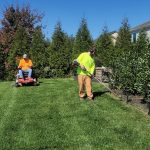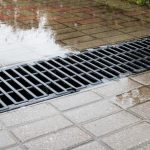Retaining walls are crucial structures in landscaping, providing support and preventing soil erosion. As winter approaches, these walls face extra stress from freezing temperatures, snow, and ice. Keeping them in good condition through the cold months is important to ensure stability and longevity.
Inspecting Your Retaining Walls Before Winter Hits
Getting your retaining walls ready for winter starts with a good inspection. Look for cracks or any signs of wear, including shifting in the wall structure. These small issues can become major problems during freezing and thawing cycles. Use a flashlight to check for hidden cracks or gaps that can allow moisture to enter and expand during cold conditions.
Examine the materials used in your retaining walls. Different materials like stone, concrete, and wood weather differently. Look specifically for any signs of decay in wooden walls or crumbling in stone and concrete. Make note of any areas that seem weathered or weak.
Pay attention to the drainage system around your retaining walls. Proper drainage keeps water from pooling at the base, which could add pressure to the wall. Make sure that weep holes are clear and that any drainage pipes are free from blockages. Addressing blocked drainage is vital to preventing water buildup, which can freeze and lead to damage.
Finally, create a to-do list for any repairs that need to be addressed immediately. Fix minor cracks and seal gaps in the wall before winter sets in. By taking these proactive measures, you prepare your retaining walls to withstand the harsh winter conditions ahead.
Preventing Water Damage and Ice Buildup
Water damage and ice buildup are common threats to retaining walls in the winter. Preventing these issues starts with effective water management. Ensure that the landscape surrounding your wall slopes away from it. This simple step directs water runoff away, reducing the chances of water seeping into the wall’s structure.
Install or maintain a functioning drainage system. Consider adding gravel backfill or installing drainage pipes if water tends to pool around your walls. These solutions help in channeling water away, decreasing the risk of water absorption and subsequent ice formation.
Seal your retaining wall using a waterproof sealant designed for the material of your wall. A good sealant provides a protective layer against moisture. Apply the sealant during dry weather for the best results. This step adds an extra layer of protection against both water damage and ice buildup.
During winter, regularly remove snow from the base of the wall. Allowing snow to accumulate increases the risk of ice formation, which can expand and add pressure to the wall. Use a plastic shovel to avoid damaging the wall surface while clearing snow.
Lastly, monitor your wall throughout the winter. Check for signs of water accumulation or ice formation after rain or snow. Address issues immediately to prevent further damage. These practices ensure your retaining walls remain sturdy throughout the winter season.
Addressing Erosion and Soil Stability Issues
Erosion and soil stability can significantly impact retaining walls, especially during winter. As the ground freezes and thaws, soil can shift, putting extra pressure on these structures. To handle this, start by assessing the land around your retaining walls. Look for signs of erosion, such as exposed roots or patches where soil has visibly moved.
Implement methods to stabilize the soil. Planting ground covers or shrubs is a natural way to help hold soil in place. Their roots can form a network, anchoring the earth and reducing erosion. Choose hardy plants that survive winter conditions to ensure ongoing protection.
Another effective strategy involves using landscape fabric and mulch. Lay down fabric across areas prone to erosion and cover it with mulch to create a barrier that protects the soil from being washed away. This simple fixed piece approach helps in maintaining soil stability year-round.
Consider adding terracing if your landscape features a steep slope. By breaking a slope into smaller, more manageable sections, you reduce soil movement. This method not only enhances the structural integrity of the wall but also adds visual appeal to your landscape.
Keep drainage in mind to prevent undermining soil stability. Make sure gutters and downspouts direct water away from retaining walls to avoid excessive moisture in the soil. With these tactics, you can confidently manage erosion and keep your retaining walls secure through winter.
Ongoing Maintenance and Repairs During Winter
Maintaining your retaining walls through winter involves continuous care and timely repairs. Regularly inspect walls for any new damage as winter progresses, especially after severe weather. Look for new cracks, bulges, or any sign that the wall is not holding up under the pressure of cold and moisture.
Perform minor repairs to stop small problems from escalating. Fill new cracks promptly to prevent water infiltration. Ensure sealants on the wall remain intact and reapply them as needed. Consistent vigilance lets you catch issues early, minimizing the risk of severe damage.
Watch for signs of shifting or leaning in your retaining walls. A tilting wall can signal deeper issues with the design or the foundation that need expert attention. Addressing these problems quickly can save the wall from eventual failure and costly repairs.
Clear debris such as fallen leaves and twigs from the wall’s surroundings. This includes keeping drainage systems free of obstructions to ensure proper water flow and reduce pressure against the wall. Regular maintenance efforts reinforce the structure, enabling it to withstand the weight of winter conditions.
Remember, ongoing maintenance is a proactive approach that ensures your retaining walls remain a strong and beautiful part of your landscape. With care and commitment, they will serve you well through every season.
Conclusion
The well-being of your retaining walls through the winter months is an essential part of maintaining your landscape’s overall health and appearance. With careful inspection, effective erosion control, and regular maintenance routines, you can ward off potential issues before they become significant problems. When you keep your retaining walls in optimal condition, you ensure their longevity and functionality, which enhances the safety and beauty of your property.
As we navigate through winter together, trust Bright Green Landscapes for all your landscaping in Elgin, IL. Our experienced team understands the challenges of maintaining outdoor spaces in cold weather. We’re here to provide the expertise and solutions that keep your landscape stunning all year round. Let us help you protect and enhance your environment with services tailored to your unique needs.







